
Bonsai is the Japanese art of growing and training miniature trees in containers, developed from the traditional Chinese art form of penjing. Penjing and bonsai differ in that, the former, attempts to display “wilder,” more naturalistic scenes, often representing landscapes, including elements such as water, rocks or figurines; on the other hand, bonsai typically focuses on a single tree or a group of trees of the same species, with a higher level of aesthetic refinement. Similar versions of the art exist in other cultures, including the miniature living landscapes of Vietnamese Hòn non bộ. It was during the Tang dynasty, when penjing was at its height, that the art was first introduced in Japan.
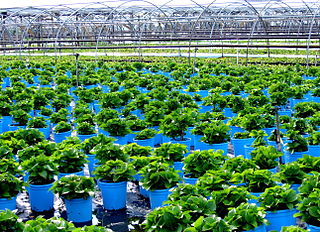
A nursery is a place where plants are propagated and grown to a desired size. Mostly the plants concerned are for gardening, forestry or conservation biology, rather than agriculture. They include retail nurseries, which sell to the general public, wholesale nurseries, which sell only to businesses such as other nurseries and to commercial gardeners, and private nurseries, which supply the needs of institutions or private estates. Some will also work in plant breeding.
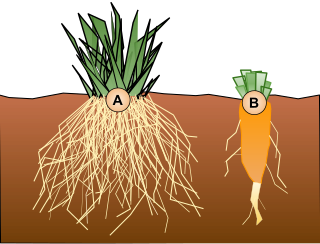
A taproot is a large, central, and dominant root from which other roots sprout laterally. Typically a taproot is somewhat straight and very thick, is tapering in shape, and grows directly downward. In some plants, such as the carrot, the taproot is a storage organ so well developed that it has been cultivated as a vegetable.
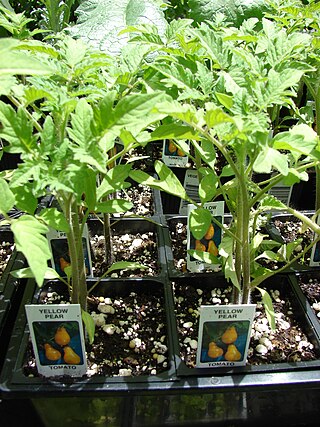
Plugs in horticulture are small-sized seedlings grown in seed trays filled with potting soil. This type of plug is used for commercially raising vegetables and bedding plants. Similarly plugs may also refer to small sections of lawn grass sod. After being planted, lawn grass may somewhat spread over an adjacent area.

The tamarillo is a small tree or shrub in the flowering plant family Solanaceae. It is best known as the species that bears the tamarillo, an egg-shaped edible fruit. It is also known as the tree tomato, tomate de árbol, tomate andino, tomate serrano, blood fruit, tomate de yuca, tomate de españa, sachatomate, berenjena, chilto and tamamoro in South America, tyamtar, rambheda or rukh tamatar in Nepal, and terong Belanda in Indonesia. It is popular globally, especially in Peru, Colombia, New Zealand, Ecuador, Nepal, Rwanda, Burundi, Australia, Bhutan and the United States.

In agriculture and gardening, transplanting or replanting is the technique of moving a plant from one location to another. Most often this takes the form of starting a plant from seed in optimal conditions, such as in a greenhouse or protected nursery bed, then replanting it in another, usually outdoor, growing location. The agricultural machine that does this is called a transplanter. This is common in market gardening and truck farming, where setting out or planting out are synonymous with transplanting. In the horticulture of some ornamental plants, transplants are used infrequently and carefully because they carry with them a significant risk of killing the plant.

Girdling, also called ring-barking, is the complete removal of the bark from around the entire circumference of either a branch or trunk of a woody plant. Girdling results in the death of the area above the girdle over time. A branch completely girdled will fail and when the main trunk of a tree is girdled, the entire tree will die, if it cannot regrow from above to bridge the wound. Human practices of girdling include forestry, horticulture, and vandalism. Foresters use the practice of girdling to thin forests. Animals such as rodents will girdle trees by feeding on outer bark, often during winter under snow. Girdling can also be caused by herbivorous mammals feeding on plant bark and by birds and insects, both of which can effectively girdle a tree by boring rows of adjacent holes.

This article presents common techniques and facts regarding the cultivation of cannabis, primarily for the production and consumption of its infructescences. Cultivation techniques for other purposes differ.

Layering has evolved as a common means of vegetative propagation of numerous species in natural environments. Layering is also utilized by horticulturists to propagate desirable plants.

A plant cutting is a piece of a plant that is used in horticulture for vegetative (asexual) propagation. A piece of the stem or root of the source plant is placed in a suitable medium such as moist soil. If the conditions are suitable, the plant piece will begin to grow as a new plant independent of the parent, a process known as striking. A stem cutting produces new roots, and a root cutting produces new stems. Some plants can be grown from leaf pieces, called leaf cuttings, which produce both stems and roots. The scions used in grafting are also called cuttings.

Container gardening or pot gardening/farming is the practice of growing plants, including edible plants, exclusively in containers instead of planting them in the ground. A container in gardening is a small, enclosed and usually portable object used for displaying live flowers or plants. It may take the form of a pot, box, tub, basket, tin, barrel or hanging basket.
Passive hydroponics, semi-hydroponics or passive subirrigation is a method of growing plants without soil, peat moss, or bark.
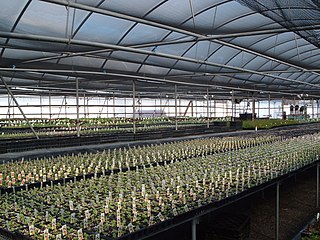
"Liners" is a horticultural term referring to very young plants, usually grown for sale to retailers or wholesalers, who then grow them to a larger size before selling them to consumers. Liners are usually grown from seed, but may also be grown from cuttings or tissue culture. They are grown in plastic trays with many "cells," each of which contains a single liner plant. Liners will typically range in size from a 36 cell tray up to a 288 cell tray. The most common size used in commercial nurseries is between 50 and 72 cells. The term "liner", is typically used for perennial, ornamental, and woody seedlings. Annuals in this form are usually referred to as plugs.

Carmona is a genus of flowering plants in the borage family, Boraginaceae. Members of the genus are commonly known as scorpionbush.

A flowerpot, planter, planterette or plant pot, is a container in which flowers and other plants are cultivated and displayed. Historically, and still to a significant extent today, they are made from plain terracotta with no ceramic glaze, with a round shape, tapering inwards. Flowerpots are now often also made from plastic, metal, wood, stone, or sometimes biodegradable material. An example of biodegradable pots are ones made of heavy brown paper, cardboard, or peat moss in which young plants for transplanting are grown.
Ebb and flow are two phases of the tide or any similar movement of water. The ebb is the outgoing phase, when the tide drains away from the shore, and the flow is the incoming phase when water rises again. The terms are also common in figurative use.

Indoor bonsai are bonsai cultivated for the indoor environment. Traditionally, bonsai are temperate climate trees grown outdoors in containers. Tropical and sub-tropical tree species can be cultivated to grow and thrive indoors, with some suited to bonsai aesthetics shaped as traditional outdoor or wild bonsai.
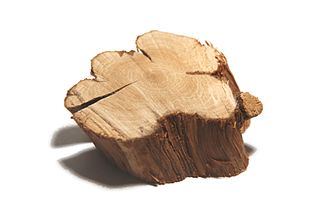
A woody plant is a plant that produces wood as its structural tissue and thus has a hard stem. In cold climates, woody plants further survive winter or dry season above ground, as opposite to herbaceous plants that die back to the ground until spring.

Bonsai cultivation and care involves the long-term cultivation of small trees in containers, called bonsai in the Japanese tradition of this art form. Similar practices exist in other Japanese art forms and in other cultures, including saikei (Japanese), penjing (Chinese), and hòn non bộ (Vietnamese). Trees are difficult to cultivate in containers, which restrict root growth, nutrition uptake, and resources for transpiration. In addition to the root constraints of containers, bonsai trunks, branches, and foliage are extensively shaped and manipulated to meet aesthetic goals. Specialized tools and techniques are used to protect the health and vigor of the subject tree. Over time, the artistic manipulation of small trees in containers has led to a number of cultivation and care approaches that successfully meet the practical and the artistic requirements of bonsai and similar traditions.
There are various methods of tree shaping. There are strengths and weaknesses to each method as well commendable tree species for each process. Some of these processes are still experimental, whereas others are still in the research stage. These methods use a variety of horticultural and arboricultural techniques to achieve an intended design. Chairs, tables, living spaces and art may be shaped from growing trees. Some techniques used are unique to a particular practice, whereas other techniques are common to all, though the implementation may be for different reasons. These methods usually start with an idea of the intended outcome. Some practitioners start with detailed drawings or designs. Other artists start with what the tree already has. Each method has various levels of involvement from the tree shaper.


















